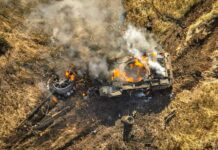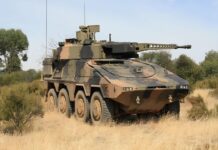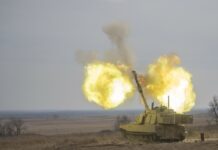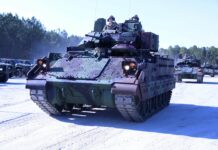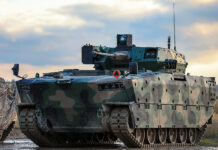Turrets are central to armoured fighting vehicle (AFV) design and house many of the most important subsystems on any platform. These can include the main armament, sensors, fire control systems, and protection systems. The choice of turret can affect greatly what a system can or cannot do.
The market for standalone turrets provides potential users with many options to select from, with many having similar characteristics. Standalone turret choices range from those housing the 12.7 mm heavy machine gun, up to those armed with a 120 mm smoothbore gun. This article will examine the wide variety of turrets, including both large- and medium-calibre turrets, and explore common types of configurations that industry offers.
A natural convergence
The term ‘AFV’ covers a large variety of vehicle types, many from which have evolved their capabilities and roles significantly over the past 70 years. Examples include main battle tanks (MBTs), infantry fighting vehicles (IFVs), armoured personnel carriers (APCs), among other specialised vehicle-types. An AFV is principle any type of vehicle that is armoured from the design stage and has the ability to engage in a variety of combat and combat support roles.
The majority of AFVs that possess an armament greater than that of a light 5.56 mm or general purpose 7.62 mm machine gun will almost always possess a turret mounted above the hull. The usage of turrets as the main structural element housing the vehicle’s armaments began in 1918 with the arrival of the Renault FT. This truly revolutionary design ended the initial experiments with mounting multiple cannons onto tanks using sponsons protruding from the hull’s sides, as can be seen on the British series of tanks during WWI. Similarly, while casemate designs were used during WWII for tank destroyer designs and by a limited number of designs during the Cold War such as the West German Kanonenjagdpanzer or Sweden’s Stridsvagn 103 (S-tank), a consensus emerged that the use of a turret housing the main armament and accompanying subsystems is the most effective design.
With the emergence of the APC and IFV post-war, turrets have also been utilised to arm these classes of vehicles with machine gun or medium-calibre cannon armaments, often being small-sized turrets with some even being operated by a single crewman. Given that both the APC and IFV are not equipped with heavy and bulky large-calibre guns, such as those used by tanks, these classes of vehicles have been the first to undergo the evolution of turrets from manned and mechanically-operated to unmanned and automated. Additionally, the continuing need to increase the lethality of AFVs means that both contemporary APCs and IFVs are now often equipped with 30 mm cannons. This looks set to increase further, with new cannon designs of 40 mm, 50, mm emerging, and the Russians reviving the 57 mm cannon for use on the AU-220M turret.

Credit: Yugoimport
With an increase in automation, the expansion of situational awareness sensors and technologies, and the availability of higher calibre weapon systems, the options for turrets for modern AFVs can appear endless, with a wide array of manufacturers globally who market standalone turrets to retrofit legacy fleets or for new-build AFVs.
Contemporary turret development
Turrets for AFVs have undergone a gradual evolution in their attributes throughout the last half-century and have attained considerable advances in firepower, protection, and situational awareness. One of the most notable developments in turret design has been the adoption of an autoloader for the main armament. This has produced two major advantages over AFVs without autoloaders – a decrease in the required size and weight of turrets, and removing the need for a loader crewman. For military planners, this can make a huge difference in manpower requirements for armoured formations by reducing the crew needed to operate a tank by a quarter.
A significant advance in the construction of turrets has also improved the protection of modern turret. This is a result of a gradual transition from cast to welded turrets. Cast turrets and hulls had been the norm up to and around the late-Cold War. Welded turrets have been found to be slightly lighter than a cast turret of equivalent protection rating, at the cost being more labour-intensive to mass-produce. The transition to welded turrets has been marked by turrets with typically flatter surfaces than their curvier cast turret counterparts. Flatter surfaces, have in turn made it easier to mount appliqué armour packages, and explosive reactive armour (ERA) tiles. Today, most recently produced tanks have welded turrets built on a steel base, with composite modular armour packages often built onto the steel at production. The usage of composite materials was a significant advancement as it could offer better protective capabilities at a lower mass or size relative to older rolled homogenous armour (RHA). Composite armour was first applied to tanks and has also been used during the construction of turrets, beginning with the T-64.
Turrets for lighter AFVs like APCs and IFVs have not seen a wide-application of such protection measures due to an arguably more significant advancement – automation. With the removal of the loader in place of the autoloader, and the electrification of formerly mechanical interfaces and key subsystems for the commander and gunner, the natural progression was to remove the remaining two crewmen from the turret altogether. A turret no longer needs to have the physical presence of the two crewmen needed to operate, and this allowed the reallocation of protection and weight towards the hull. This has led to a further reduction in the volume and weight of a turret by removing the turret basket, as well as allowing designers to isolate the turret from the hull by using a non-hull-penetrating design.
Accompanying the emergence of unmanned turrets, the quantity and quality of sensors that allow greater situational awareness has increased on modern turrets. Turrets would previously have a limited number of periscopes, a gunner’s sight with a possible backup, sometimes an independent sight for the commander, and allowed the commander to emerge from his hatch, albeit at the cost of partially emerging from the armour protection of the turret. As optical sights became gradually replaced with optronic sights and the connection to vision systems no longer went through a physical optical connection but through an electric cable, the possibilities of for equipping the crew with a vast array of sophisticated visual sensors has increased.

Credit: GDLS
Large-calibre gun turrets
Turrets can vary in attributes but a distinction between turret options can be found between the few that are marketed with large-calibre guns versus the plethora of medium-calibre turret options. While exceptions exist, in general tank turrets are typically those that wield a large-calibre guns, most commonly ranging from 100 mm to 125 mm guns. They are also still manned by crew members within the turret, although some future tank designs are showing a shift towards unmanned tank turrets. Similarly, the autoloader has not been embraced by all tank designs at the moment, but with several next-gen tank designs using unmanned turrets as well as larger and heavier munitions, their adoption would necessitate the use of autoloaders.
Unlike other AFVs, MBTs are typically equipped with the same turret that they left the factory with. While there are exceptions to this – for instance in one Cold War project, an M60 Patton was tested with a Leopard 2 turret, however, in general these projects were rarely progressed beyond a prototype vehicle. However, there appears to be some opportunity for ‘re-turreting’ MBTs when the costs and delivery times of most military equipment is now at a relative high due largely to the ongoing conflict in Ukraine and increased demand for a wide range of military equipment.
Hitfact MkII 105/120mm
A recent example has emerged from Greece in late November, with a meeting between the Greek general staff and representatives of Leonardo S.p.A., who have meant to present their proposals for modernising Greece’s significant but antiquated Leopard 1A5 fleet. One proposal reportedly under consideration is to upgrade Greece’s Leopard 1A5 tanks with the Hitfact Mk2 105/120mm turret. The Hitfact MkII owes its lineage to the MkI variant, used on the Centauro 120 trials vehicle. Efforts have been made with the updated MkII for a pitch towards retrofitting older MBTs as well as some 8×8 wheeled vehicles.

Credit: Leonardo
The turret can be armed with a 105 mm L52 rifled gun, the same calibre of the original gun on the Leopard 1, or with a low-recoil 120 mm L45 gun. The Hitfact can be manned by two crew thanks to its autoloader that carries 12 rounds of ammunition, regardless of whether the turret is armed with the 105 or 120 mm. The option for a three-person crew with manual loading is also offered. This turret would allow the Leopard 1 to use the 120 mm gun, allowing compatibility with Greece’s Leopard 2 fleet. It would also allow the tank to receive a modern fire-control system (FCS) with stabilised sights, meteorological sensors, a ballistic computer and automatic target tracking. In addition, the turret can be equipped with a battle management system (BMS), which provides a variety of means to improve coordination with friendly forces.
Overall, the turret offers a substantial firepower and mission systems upgrade for legacy MBTs such as Leopard 1A5. Additionally, the 120 mm configuration has been selected for use on Italy’s Centauro II fire support vehicle, demonstrating the viability of this armament on an 8×8 platform.
Cockerill 3105 & CSE 90LP
Belgium-based John Cockerill also offers a comparable product, in the form of the Cockerill 3105. The two-person turret houses a 105 mm rifled gun coupled to an autoloader that stores 12-16 rounds, depending on the configuration. The turret has been seen on a Leopard 1 at Eurosatory 2022, demonstrating its viability on the platform. Modifications required the installation of a turret ring adapter as well as integrating the turret with the Leopard 1’s electrical supply. As with the Hitfact, the key advantage a turret like this could provide to legacy MBTs is a suite of modern mission systems, along with a reduction in weight and crew. The 3105 has also entered service on the FNSS/PT Pindad Harimau tracked fire support vehicle (FSV) for Indonesia, and the GDLS-Canada LAV-700 FSV for Saudi Arabia. Other platforms the turret has been mounted on for testing include the GDLS-Canada LAV-III, Hanwha K-21, and the Otokar Tulpar.

Credit: John Cockerill
John Cockerill also offers the CSE 90LP two-person turret, which is armed with a 90 mm rifled gun. The turret offers a baseline protection rating of STANAG 4569 Level 1, but has proven light enough to have been trusted on smaller vehicles such as the Akrep II 4×4. It has one of the most varied applications of the turrets listed so far, having been integrated and tested on all types of vehicles from a Ukrainian BTR-3 8×8, to the M1117 Guardian 4×4. Setups such as these enable relatively light vehicles to provide meaningful mobile fire support for infantry.
Medium-calibre turrets
Options for medium-calibre turrets are far greater in variety than large-calibre turrets. In some respects, this is due to the fact that most land armies maintain their direct fire large-calibre armaments on their MBTs, without requiring a similar capability mounted on IFV or APC platform. Medium-calibre turrets are also easier to manufacture, given that they are by nature lighter due to using a smaller armament system and corresponding lighter ammunition. They are also never as heavily protected as MBT turrets, as they are not expected to engage MBTs.
The proliferation of medium-calibre turret offers has provided manufacturers of APCs and IFVs the option of forgoing development of a proprietary turret, and instead work with industrial partners and customers to select a turret solution from the wide range of options. Shown below is a table with a selection of medium-calibre turret products that are sold as a standalone product, along with some key characteristics. Following this, a selection of varying types of turrets will be explored to highlight the common differences of those available on the market today.
| Turret | Country of origin | Manned/ Unmanned | Main armament calibre (mm) | ATGM |
| 32V01 | Russia | Unmanned | 30 | No |
| AMICT | South Africa | Manned | 30 | No |
| AU-220M | Russia | Unmanned | 57 | No |
| Berezhok | Russia | Manned | 30 | Yes |
| Cockerill 1030 | Belgium | Unmanned | 30 | No |
| Cockerill 3030 | Belgium | Both available | 30 | No |
| Guardian 30 | Spain | Unmanned | 30, 40 | Yes |
| Hitfist | Italy | Manned | 25, 30, 40 | No |
| Hitfist UL | Italy | Unmanned | 30 | No |
| LANCE | Germany | Both available | 30 | Yes |
| Mizrak | Turkey | Unmanned | 30 | Yes |
| Nefer | Turkey | Unmanned | 25, 30 | No |
| Protector RT60 | Norway | Unmanned | 30, 40 | Yes |
| RIwP | USA | Unmanned | 12.7, 25, 30 | Yes |
| Samson 30 | Israel | Unmanned | 30, 40 | Yes |
| T40 CTA | France | Both available | 40 | Yes |
| ZSSW-30 | Poland | Unmanned | 30 | Yes |
| Note: All information derived from open sources. The above is a selection rather than an exhaustive list of all medium-calibre turrets available. | ||||
ZSSW-30
The ZSSW-30 is a Polish turret which was indigenously-developed by a consortium comprising Huta Stalowa Wola (HSW) and WB Group. Poland is looking to integrate the turret on its first indigenous IFV, the Borsuk, as well as some of its Rosomak 8×8 vehicles. In addition to Borsuk and Rosomak, Hanwha has also offered Poland the option to mount this turret on the AS21 Redback IFV, should Poland select the vehicle.

Credit: Polish MoD
The ZSSW-30 is to be armed with a 30 mm Mk44/S Bushmaster II chambered in the 30 × 173 mm cartridge. The turret is also equipped with a pod-mounted pair of Spike-LR II ATGMs, enabling the crew to engage armoured targets out to a range of 5.5 km, and a UKM-2000C 7.62 mm machine gun. The FCS was developed by WB group, and includes a meteorological sensor, ballistic computer, and stabilised independent sights for the gunner and commander with day and thermal channels. The latter enables the crew to carry out hunter-killer engagements. An obscurant smoke-based soft-kill active protection system (APS) is also included, comprising laser warning receivers (LWRs) linked to smoke dischargers. When the LWRs detect a laser illumination threat, they can activate the smoke grenade launchers, creating a bank of multispectral obscurant that can hinder enemy targeting, and obscure the vehicle from infrared homing ATGMs.
T40 CTA
The French T40 CTA will likely be the only in-service turret armed with the CT40, a 40 mm cased telescoped cannon, until the UK’s Ajax reconnaissance vehicle enters service later in the decade. The turret is offered in both manned and unmanned configurations, with the former being selected for the EBRC Jaguar reconnaissance vehicle chosen by France and Belgium, and the latter demonstrated on the developmental VBCI-2 8×8.
Perhaps the most noteworthy feature of this turret is its main armament – the CT40, which possesses several unique features. Cased telescoped ammunition is a design wherein the projectile is encased completely within the cartridge, as opposed to conventional ‘bottle shaped’ ammunition, which have the projectile protruding from the top of the cartridge. Cased telescoped ammunition is typically slightly wider than an equivalent conventional munition, but is significantly shorter. This provides volume savings which allow higher number of rounds to be carried than with equivalent performance conventional munitions.
The CT40 also offers interesting ammunition natures, such as the Kinetic Energy Airburst (KE-AB) round, a programmable airburst munition that unleashes a payload of tungsten pellets with a directional effect. This round is designed to engage low-flying aerial targets at a range of up to 3,500 m. The General-Purpose Round Point Detonation Tracer (GPR-PD-T) round is intended for engaging structures and light armoured vehicles. It is capable of penetrating up to 210 mm of concrete, or 15 mm of RHA equivalent at 1,000 m. The cannon not only provides long-range firepower, but its range of ammunition natures as well as its ammunition handling and feed system allow the operators of the T40 CTA turret to take multiple ammunition natures in their loadout, as opposed to the more typical limit of two ammunition natures for dual-feed cannons.
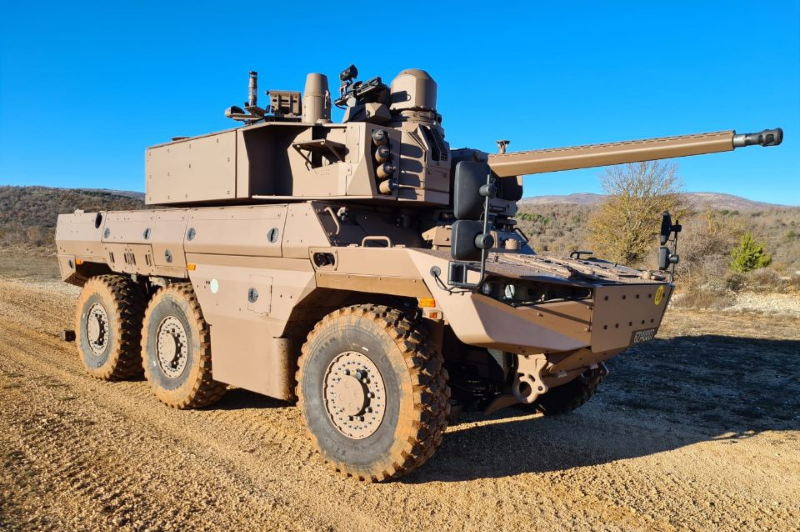
Credit: Armée de Terre
For engaging armoured targets, the turret is equipped with a pop-up launcher for ATGMs, with known options including the MBDA Akeron-MP ATGM. The turret also has a comprehensive sensor suite, given that it is designed to be mounted on a reconnaissance vehicle. The FCS includes independent sights with day and thermal channels for the gunner and commander, enabling hunter-killer engagements, as well as a meterological sensor and ballistic computer. Additionally, the turret can also be equipped with a passive acoustic gunshot detection sensor for rapidly locating the source of incoming fire.
RwIP
RwIP turret is perhaps the closest solution towards a universal user-configurable turret design – capable of being outfitted to engage both ground- and air-targets if the armament is configured so. The RwIP perhaps leads the growing trend of ‘modularity’, with the ability to pick and choose many characteristics desired for a platform.
The RwIP is not laid out like other unmanned turrets. It more closely resembles a skeleton frame onto which various weapons can be integrated, including machine guns, automatic grenade launchers, an automatic cannon, rockets, ATGMs, or MANPADS, even both of the latter simultaneously. The RwIP is one of very few turrets that offers the ability to also include MANPADS without having to lose its primary direct fire armament. This allows for providing manoeuvre units with organic SHORAD capabilities without sacrificing as much in the way of direct fire capability.

Credit: Moog Inc.
The RwIP can be armed with a large array of weaponry, ranging from machines guns such as the 12.7 mm M2 Browning up to the M230LF or 30 mm XM813 cannon. Although the turret is unmanned, its protection rating can be optionally increased through add-on armour options, depending on user requirements. The turret is typically shown with a single optronic sight for the gunner, however, an independent sight for the commander can be optionally added. It is currently in service with the US Army on the Stryker M-SHORAD variant.
An abundance of choice
Turrets on AFVs have been around for over a century and continue to evolve with new capabilities that improve a system’s protection and lethality in the field. Sensor and vision systems equipment have undergone electrification, allowing unmanned operation of the turret. This allows the crew to reside in the hull, saving both weight and volume on armouring the turret. This in turn has follow-on benefits for vehicle transportability and tactical mobility.
Large-calibre turrets, can provide new-build vehicles with direct-fire large-calibre guns and also be used to retrofit legacy MBTs. The latter could prove to be a relatively financially sensible solution for forces that lack the funds to procure new MBT fleets but may have legacy vehicles that would greatly benefit from modernisation.
Medium-calibre turrets covers a huge variety of designs with a broad range of manufacturers around the globe. The sheer range of modern turret options available for AFVs allows users to obtain sophisticated combat capabilities while also offering the chance to reduce turret volume, at a lower weight penalty than many of their forebears.
Chris Mulvihill



